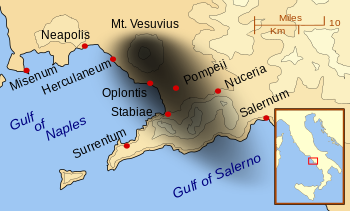Oplontis
 | |
| Location | Torre Annunziata, Province of Naples, Campania, Italy |
|---|---|
| Site notes | |
| Management | Soprintendenza Speciale per i Beni Archeologici di Napoli e Pompei |
| Website | Oplontis Template:It icon |
| Official name | Archaeological Areas of Pompeii, Herculaneum, and Torre Annunziata |
| Type | Cultural |
| Criteria | iii, iv, v |
| Designated | 1997 (21st session) |
| Reference no. | 829 |
| Region | Europe and North America |

Oplontis was a town near Pompeii, in the Roman Empire. On August 24, AD 79, the eruption of Mount Vesuvius buried it under a deep layer of ash. It is the location of the Villa Poppaea, possibly associated with the second wife of Emperor Nero,[1] was excavated in the mid-20th century, wrapping up in 1984,[2] and is currently open to the public.
A second villa, the Villa of L. Crassius Tertius, was discovered in 1974, 300 metres east of the Villa of Poppaea,[3] during the construction of a school. A bronze seal bearing Crassius' name was found at the site.
The name "Oplontis" most likely referred originally to the baths in the area of Campo Oncino, but today the name commonly covers the group of villas in the middle of the modern town of Torre Annunziata (Torre Nunziata in the local Neapolitan dialect).
A large number of artifacts from Oplontis are preserved in the Naples National Archaeological Museum.
See also
External links
- Official website (English-language version)
- The Oplontis Project
- AD79 Year of Destruction Website
References
- ^ "The Oplontis project". The University of Texas at Austin, Soprintendenza Archeologica di Pompei. Retrieved 20 April 2012.
- ^ "Oplontis". archive.fieldmuseum.org. Retrieved 24 March 2013.
- ^ "Villa B". The University of Texas at Austin, Soprintendenza Archeologica di Pompei. Retrieved 20 April 2012.
- Pre-Roman cities in Italy
- Populated coastal places in Italy
- Cities and towns in Campania
- Destroyed cities
- Former populated places in Italy
- Pompeii (ancient city)
- Roman sites of Campania
- Populated places established in the 1st millennium BC
- Visitor attractions in Campania
- World Heritage Sites in Italy
- Archaeological sites in Campania
- Torre Annunziata
- Campanian geography stubs



